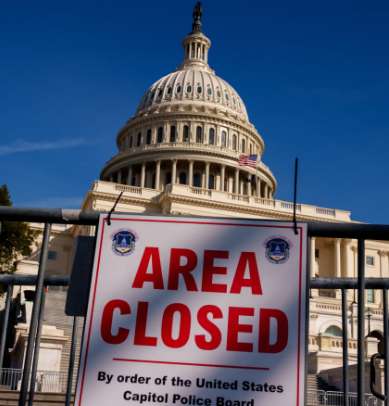Disappearing Data Is About to Force The Fed To Make Its Toughest Call Yet?
The ongoing U.S. government shutdown is leaving policymakers “flying blind” at a critical moment for the American economy. As Federal Reserve officials approach their late-October rate decision—debati

The ongoing U.S. government shutdown is leaving policymakers “flying blind” at a critical moment for the American economy. As Federal Reserve officials approach their late-October rate decision—debating whether to continue cutting rates or hold them steady-a funding lapse has forced several key statistical agencies, including the Bureau of Labor Statistics (BLS) and the Bureau of Economic Analysis (BEA), to scale back operations. The result: severe delays in the release of crucial economic data.
The Consumer Price Index (CPI) report, originally scheduled for October 15, has been postponed to October 24, while the monthly employment report and retail sales data-core indicators of economic performance-have been pushed back indefinitely.
When the Fed’s policy committee meets on October 28–29, officials will be forced to rely more heavily on historical data, existing trends, market signals, and private-sector alternative data to gauge the state of the economy. This “data vacuum” makes policymaking significantly more difficult. Without official statistics, the Fed cannot accurately determine whether inflation has stabilized within its target range or assess the pace of labor market cooling.
How the Shutdown Is Disrupting Data Collection
The impact of the shutdown on the government’s ability to collect key economic data has drawn intense market scrutiny—most notably over the monthly CPI report, a cornerstone of the Fed’s policy framework. The BLS typically collects about 80,000 individual price observations each month through three 10-day collection cycles, largely by manual sampling.
According to Morgan Stanley economists on October 10, the BLS has already lost roughly one-third of its October price data due to the shutdown. Erica Groshen, who served as BLS Commissioner during the 2013 shutdown, noted that while the agency can compensate for missing data through overtime work or “imputation” methods (filling in gaps with comparable data), data quality will steadily deteriorate the longer the shutdown persists.
Omair Sharif, president of Inflation Insights LLC, warned in an October 9 interview: “From this point forward, the accuracy of the data will only get worse. By the third week, we may be dealing with extremely low-quality or even missing data.”
The BEA’s Personal Consumption Expenditures (PCE) price index—another key inflation gauge that uses CPI data as a major input—will also be affected. Other government indicators, however, may suffer less disruption.
The BLS’s monthly employment report, for instance, relies on two separate surveys: an establishment survey of employers and a household survey that determines the unemployment rate. According to Morgan Stanley, employers generally retain their own payroll data, making job creation estimates less vulnerable to delays, while the household survey’s response rate remained stable during the 2013 shutdown.
Meanwhile, the Census Bureau’s retail sales report—largely submitted via mail and online—may be “largely unaffected” by the shutdown.
Historical Precedents
This marks the 15th U.S. federal government shutdown since 1981. Each time, agencies have been forced to suspend operations due to lapses in funding. At least four of those shutdowns have caused significant delays in major economic reports.
During the 21-day shutdown from December 1995 to January 1996, the monthly employment report was delayed by two weeks. Then-BLS Commissioner Katharine Abraham recalled that response rates for household surveys fell and data collection was interrupted, though later analysis concluded the disruption “did not materially affect the estimates.”
The employment reports for September and October 2013 were also postponed due to that year’s autumn shutdown. Other key data from the Census Bureau and BEA—including trade, retail sales, and GDP estimates—were also delayed.
The 35-day shutdown that began in December 2018—the longest in U.S. history—caused even greater data disruption. Releases for retail sales, GDP, and other core indicators were postponed, while some statistics, such as early-stage trade and inventory data, were permanently canceled and never published.
Notably, the BLS continued to operate during that period, thanks to carryover funding, allowing it to release its jobs and CPI reports on schedule—an advantage that does not appear to exist in the current shutdown.
Private-Sector Alternatives
In the absence of official statistics, private-sector data providers have become critical substitutes. Many firms have long maintained their own economic indicators, which become especially valuable during shutdowns and continue to supplement government data afterward.
For instance, ADP Research publishes monthly private-sector employment estimates based on a sample of over 26 million workers; Indeed tracks job vacancies; Challenger, Gray & Christmas reports corporate layoff announcements; and Revelio Labs analyzes more than 100 million online résumés to produce independent labor market estimates.
Wall Street institutions have also stepped in: the Carlyle Group and Bank of America publish labor market updates, including wage growth metrics, while Goldman Sachs uses state-level unemployment claims data to construct jobless rate estimates.
Although these private indicators differ in methodology, scope, and statistical rigor—and cannot fully replace official reports—their cross-validation offers valuable insights for investors and policymakers navigating a data blackout.
What Data Will the Fed Rely On?
The Fed’s next rate decision comes amid two competing pressures: a cooling labor market and renewed inflationary effects from tariffs. Even with limited information, policymakers are trying to strike a balance.
In an October 10 interview, Fed Governor Christopher Waller acknowledged the value of alternative data sources such as reports from the Carlyle Group and ADP, noting that Carlyle’s data showed just 17,000 new jobs in September.
The BLS is expected to release the September CPI report before the Fed’s meeting, offering a crucial read on inflation. However, the shutdown has already disrupted the collection of October data, and the November CPI release may be delayed—complicating future policy decisions even further.
Beyond official sources, the Fed also monitors supplementary indicators from states and private firms, including unadjusted unemployment claims, regional housing permits, and business sentiment surveys. Yet, as RBC economists warned in an October 10 report, the loss of official data will make the Fed’s job far more difficult for the rest of 2025. With a softening labor market and tariff-driven inflation both weighing on the outlook, policymakers face growing uncertainty over the true trajectory of inflation, raising the risk of misjudging their next rate move.
![]() Wallstreet Insight
Wallstreet Insight
Expert analysis on U.S. markets and macro trends, delivering clear perspectives behind major market moves.
Latest Articles

Disappearing Data Is About to Force The Fed To Make Its Toughest Call Yet?
Oct.17 2025

Bitcoin's "Digital Gold" Narrative Is Facing Its Toughest Test Yet
Oct.17 2025

The $1 Trillion Question: When Everyone's Betting on AI, Who's Left Holding the Bag?
Oct.16 2025

How a Crypto Empire Powered Trump's $10 Billion Comeback
Oct.16 2025

Watch Christopher Waller: Economic Outlook
Oct.16 2025
Disclaimer: The views in this article are from the original Creator and do not represent the views or position of Hawk Insight. The content of the article is for reference, communication and learning only, and does not constitute investment advice. If it involves copyright issues, please contact us for deletion.